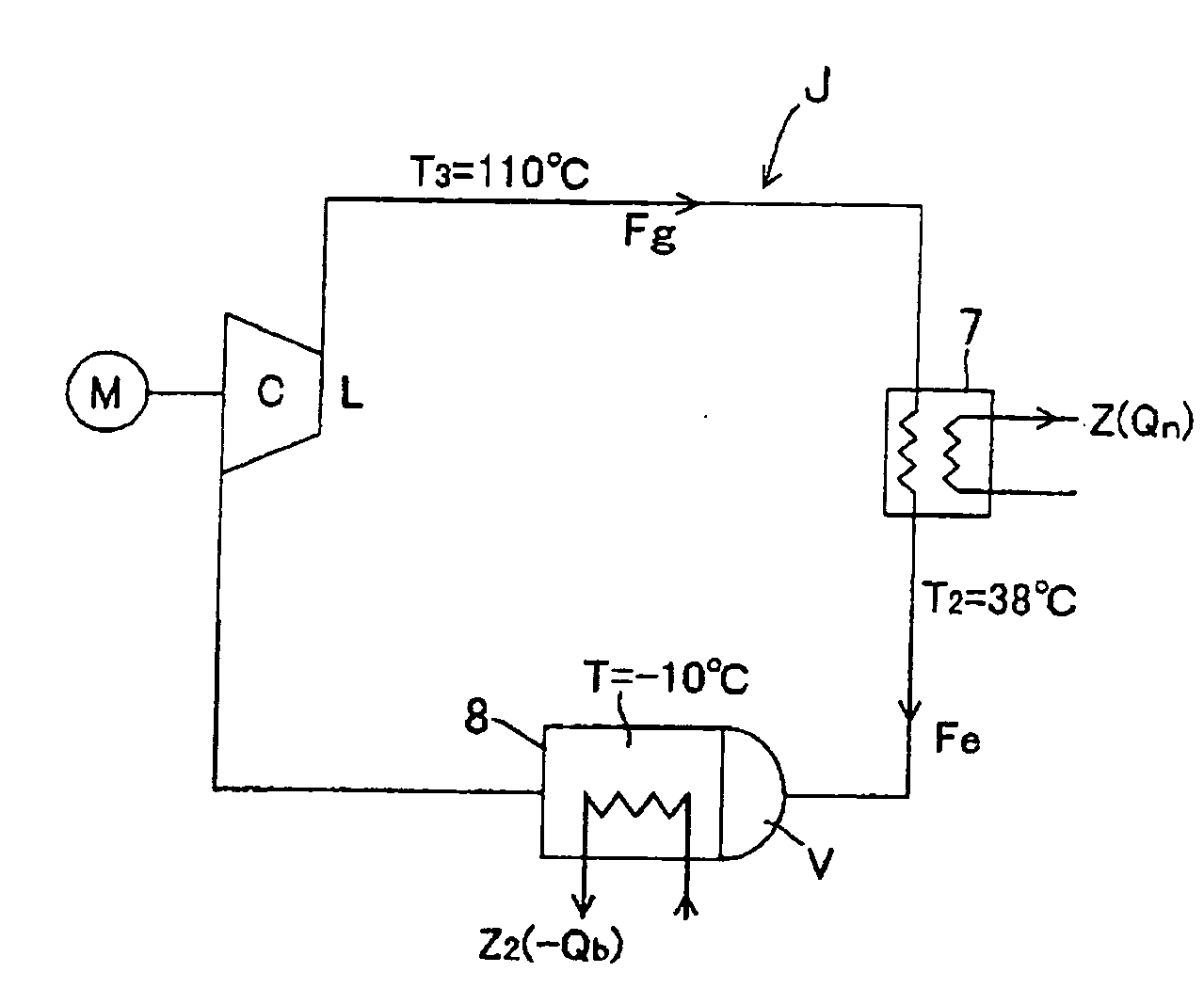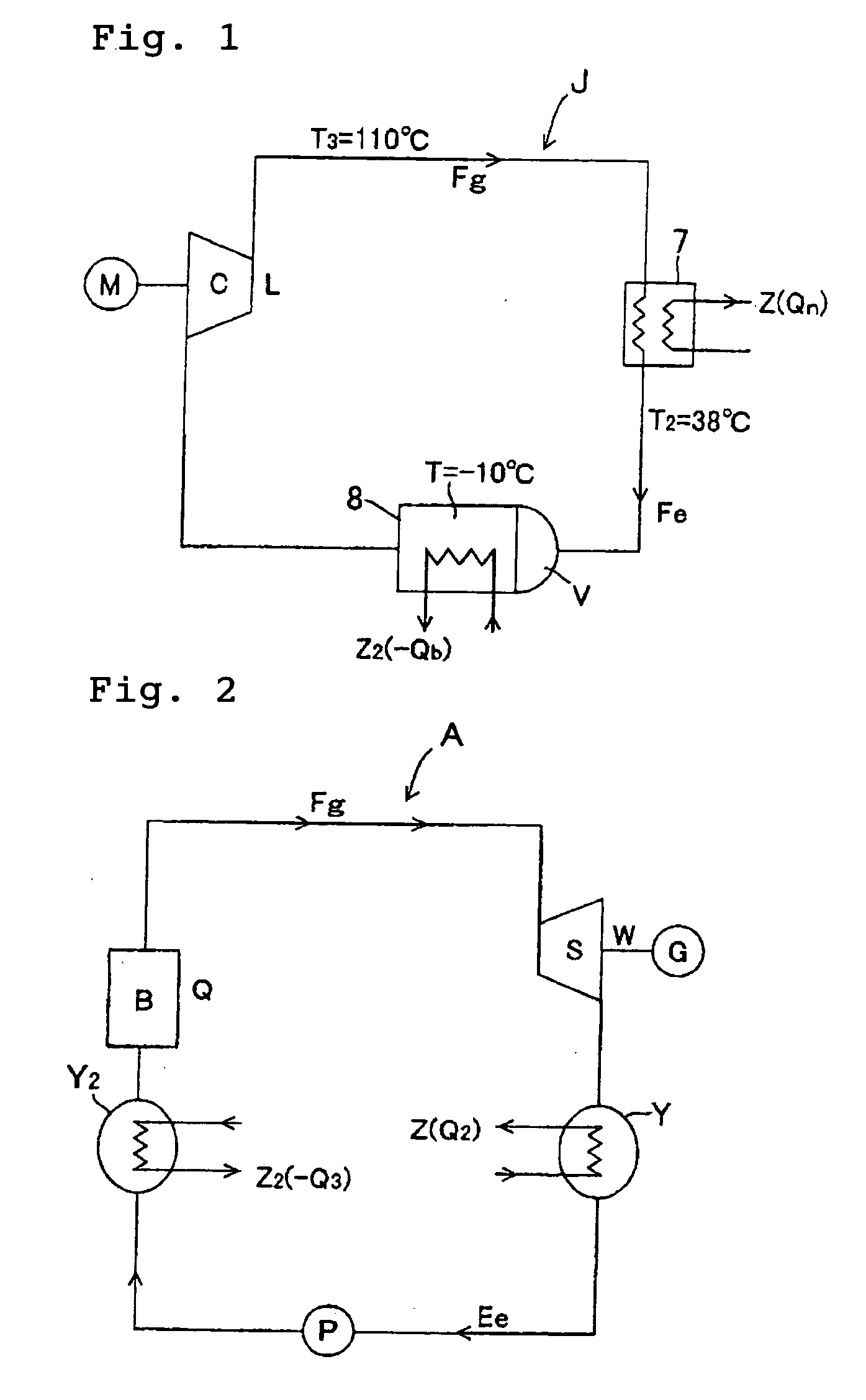Heat Cycle System and Composite Heat Cycle Electric Power Generation System
a heat cycle and electric power generation system technology, applied in the direction of machines/engines, mechanical equipment, transportation and packaging, etc., can solve the problem of difficult to increase the heat crossing ratio qsub>3/sub>/q, and achieve the effect of improving the thermal efficiency of the heat cycle electric power generation system, high efficiency, and improving the thermal efficiency of the composite heat cycle system
- Summary
- Abstract
- Description
- Claims
- Application Information
AI Technical Summary
Benefits of technology
Problems solved by technology
Method used
Image
Examples
first embodiment
[0060]FIG. 3 is an arrangement plan of a heat cycle system J according to the present invention. The heat cycle system J has an arrangement in which a turbine S and so forth are inserted into a refrigerator including a compressor C and a condenser. Working fluid (refrigerant gas Fg) compressed in the compressor C drives the turbine S to deliver work W. Thereafter, the working fluid is cooled and liquefied in a heat dissipating side 71 of a heat exchanger 7. A pump P connected to the outlet of the heat exchanger 7 sucks in the working liquid Fe and lowers the back pressure of the turbine S, thereby increasing the turbine output W and raising the pressure of the working liquid Fe. The working liquid Fe raised in pressure drives a reaction water turbine K to deliver work W2. At the same time, the working liquid Fe is expanded by the reaction water turbine K that operates as an expansion valve. Thus, the working liquid Fe evaporates to form working gas (refrigerant gas Fg). The working ...
fourth embodiment
[0068]FIG. 6 is an arrangement plan of a composite heat cycle system according to the present invention. The composite heat cycle system of FIG. 6 comprises: a refrigerator (heat pump) J including a compressor C, first and second heat exchangers 7 and 9, and an expander V; and a steam engine A including a boiler B, a second turbine S2, condenser Y, a third power generator G3 driven by the second turbine S2, and a second pump P2. The second heat exchanger 8 comprises a condenser Y of the steam engine A. In the composite heat cycle system, the working gas Fg compressed in the compressor C is chilled as it passes the heat dissipating side 71 of the first heat exchanger 7, so as to form working liquid Fe, which is in turn expanded in the expansion valve V to form low-temperature working gas Fg, which is in turn heated as it passes the heat receiving side 82 of the condenser Y, and is thereafter introduced to the compressor C.
[0069]In the composite heat cycle system according to the four...
fifth embodiment
[0070]FIG. 7 is an arrangement plan of a composite heat cycle system according to the present invention. The composite heat cycle system of FIG. 7 comprises: a refrigerator (heat pump) J including a compressor C, a first turbine S, a first heat exchanger 7, a first pump P, a water turbine K, and a first power generator G; and a Rankine heat engine A including a boiler B, a second turbine S2, a third power generator G3, a condenser Y, and a second pump P2. Working gas Fg compressed in the compressor C is chilled as it passes the heat dissipating side 71 of the first heat exchanger 7 after driving the first turbine S, and is thereafter increased in pressure by the first pump P to form high-pressure working liquid Fe, which is expanded and evaporated in the water turbine K to form working gas Fg, which is heated as it passes the heat receiving side 72 of the first heat exchanger 7 and the heat receiving side S2 of the condenser Y, and is thereafter introduced to the compressor. After d...
PUM
 Login to View More
Login to View More Abstract
Description
Claims
Application Information
 Login to View More
Login to View More - R&D
- Intellectual Property
- Life Sciences
- Materials
- Tech Scout
- Unparalleled Data Quality
- Higher Quality Content
- 60% Fewer Hallucinations
Browse by: Latest US Patents, China's latest patents, Technical Efficacy Thesaurus, Application Domain, Technology Topic, Popular Technical Reports.
© 2025 PatSnap. All rights reserved.Legal|Privacy policy|Modern Slavery Act Transparency Statement|Sitemap|About US| Contact US: help@patsnap.com



